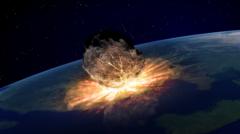A groundbreaking study has revealed that a gigantic meteorite, first identified in 2014, not only wreaked havoc on early Earth but also contributed to the flourishing of life. Discovered to be up to 200 times the size of the asteroid that led to the extinction of the dinosaurs, this ancient space rock, measuring 40-60 km in diameter, collided with Earth around three billion years ago. The impact resulted in a tsunami far surpassing those recorded in human history and led to the boiling of Earth's oceans.
The research team, led by Professor Nadja Drabon from Harvard University, journeyed to the Eastern Barberton Greenstone Belt in South Africa, a site celebrating one of the planet's oldest meteorite impacts. Armed with sledge hammers, they collected rock samples, dubbed spherules, left behind by the collision, overcoming challenges posed by the rugged terrain and local wildlife. Their goal was to understand the effects of this cataclysmic event.
Upon analyzing the rocks, the team reconstructed the sequence of events following the S2 meteorite's impact, which created a massive 500 km crater and propelled pulverized rocks into the atmosphere, forming an ash cloud that shrouded the planet. The force of the impact unleashed a colossal tsunami that reconfigured coastlines, while the resultant heat boiled oceans and raised air temperatures dramatically—conditions inhospitable for many life forms dependent on sunlight.
However, the team's surprising discovery was that these violent disruptions led to the churning up of vital nutrients such as phosphorus and iron, creating a surprisingly fertile environment. After initially devastating the simple single-celled organisms that dominated the seas, life rebounded quickly, benefitting from the enriched conditions. This resilience parallels everyday examples, according to Prof Drabon, who compares it to how bacteria rapidly repopulate after brushing one’s teeth.
The findings suggest that past impacts could have acted as natural fertilizers, boosting nutrient availability, thereby facilitating the emergence of early life forms. With implications for the timeline of life's development on Earth, the research highlights the dual nature of such catastrophic events—bringing destruction yet also paving the way for evolution and the thriving of resilience in life.
These revelations, published in the scientific journal PNAS, support an evolving perspective within the scientific community regarding the significant role of considerable impacts on the nurturing of early life.


















